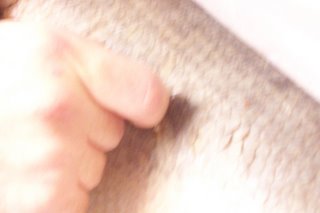Borrowed recipe, though it looks pretty good. Any substitution ideas for Pesach???
2 cups cooked rice
4 5- to 6-ounce salmon fillets
Gingered slaw:
2 cups finely shredded cabbage
1 cup shredded carrots
1 cup chopped green onions (white and green parts)
3 tablespoons rice vinegar
1 tablespoon grated fresh ginger
1 teaspoon toasted sesame oil
1 tablespoon black sesame seeds, optional
Prepare a very hot fire in your grill. You'll want the temperature to be as close to 450 degrees as you can get it.
To make the gingered slaw: In a large bowl, combine the cabbage, carrots, green onions, vegetable oil, vinegar, ginger, sesame oil, and sesame seeds, if using.
Take 4 18- by 18-inch sheets of heavy-duty aluminum foil, lay each sheet of foil on flat surface, and place 1/2 cup of cooked rice in the middle. Divide the cabbage mixture among the packets, topping the rice with it. Place the salmon fillets on top of the slaw. Wrap and seal the foil to form 4 packets.
Grill, seam side down, for 14 to 16 minutes. Do not turn. To serve, place a packet on each plate, let cool slightly, then open. Transfer the contents to 4 plates
Disclaimer: The opinions, halachic and otherwise, expressed here do not necessarily represent those of the Orthodox Union.
Tuesday, March 28, 2006
Monday, March 27, 2006
Contact me!
 An Analysis of Kaskeses – past and present
An Analysis of Kaskeses – past and presentRabbi C. Goldberg
HaModia, March 22, 2006
(Caption: Checking the scales of a Burbot [Amia Calva])
Consumers are becoming more health conscious. Fish is often considered a healthier option compared to meat. We are all familiar with certain fish like salmon and tuna. Yet, some may want to broaden their culinary experiences and try some more exotic varieties of fish. The question then becomes, what fish are kosher? This article will illustrate that it may not always be so simple to answer this question.
The Pasuk in Vayikra 11:9 describes a kosher fish as one that has “snapir v’kaskeses”, which is generally translated as fins and scales. From the Pasuk alone, one might think that a fish needs to have both simanim in order to be kosher. However, the Mishnah in Niddah 59A (expounded in Chullin 66B) tells us, “kol sheyesh bo kaskeses yesh bo snapir”, that any fish which has “kaskeses” will automatically possess “snapir”. Accordingly, in order to determine the kashrus of the fish, it would not be necessary to look at whether a fish has snapir. Instead, we simply need to confirm that it has “kaskeses”. The question remains, however, what exactly is “kaskeses”?
The Gemara discusses the definitions of “snapir” and “kaskeses”, and concludes that “snapir” refers to a fin that assists a fish in swimming, and that “kaskeses” refers to those finger-nail like protrusions on the side of a fish. The Gemara asks (in light of the knowledge that every fish possessing “kaskeses” automatically has “snapir”) what the was need for the pasuk to mention “snapir”. The Gemara responds, “Yagdil Torah V’Yadir”, that the pasuk mentions “snapir” in order to “make great” and “aggrandize” the Torah.
So, what exactly is “kaskeses”? Though it is often translated as “scales”, not all scales are included in the term “kaskeses”. The Ramban in Chumash tells us that a “kaskeses” must be able to be removed from the fish either by hand or with a knife, without ripping the underlying skin. Practically speaking, if the scale underneath the skin would rip upon removing the scale, the fish could have “fins and scales”, but not have “snapir v’kaskeses”, and it would not be kosher. The Ramban’s requirement is discussed in the Achronim[1], but is universally accepted as the halacha (see glosses of the Ramah on Y.D. 83 in the name of Maggid Mishnah).
The Poskim do not require that a kaskeses must have a particular shape, color or texture. Any scale that can be removed without ripping skin would qualify as a “kaskeses”. The only limit discussed is the size of a scale, namely that it must be large enough to be viewed by the naked eye. Both the Aruch HaShulchan and the Tiferes Yisroel mention that the kaskeses must be perceivable by the naked eye from a normal distance in order to be halachicly significant. A single “kaskeses” anywhere on the fish, appearing at any point during its lifetime is sufficient for it to be kosher. Even if the “kaskeses” fell off before the fish was caught or if the fish had yet to grow a “kaskeses” (but is of a species known to grow “kaskeses” later in life), the fish is still kosher.[2]
Applying the definition of kaskeses to the various species of fish is not always simple. Some claim that one can look at the scientific classifications of scales in order to determine whether the scale qualifies as a kaskeses. Scientifically, there are five different types of scales: placoid, cosmoid, gadoid, ctenoid and cycloid. Placoid scales are found on many different types of sharks (sharks do have scales, though they rip the skin when removed and thus cannot be considered “kaskeses”), cosmoid are found on lungfish, gadoid are found on sturgeon, gars and bowfin. These three types of scales are rarely found on kosher fish, though I mentioned bowfin (Amia Calva) as at least one example of a kosher fish with gadoid scales. The other two types, cycloid and ctenoid scales, are the ones found on most kosher fish. The scale classifications are based on varying factors, such as the make up of the scale, its relationship to other scales on a fish, and the structure of the growth rings on the edge of a scale (experts can determine how old a fish is by counting rings on its scales, much as they would rings on a tree).
Some Rabbis have postulated that any fish bearing cycloid or ctenoid scales is a kosher fish. There are several reasons why one should disagree with this assertion. One reason is that some cycloid scales are not visible to the naked eye. For example a type of sand-eel (Ammodytes Americanus) is described as having cycloid scales. The author of this article showed the fish to various persons at a major kashrus agency, and no one there was able to see anything on the fish that was large enough to consider it as having “kaskeses”. Another reason why defining the type of scale is not sufficient to know if it is kosher, is that some fish have embedded scales. American Eel (Anguilla Anguilla) is known to have scales that could be “kosher” if not for the fact that they are deeply embedded into the skin. The same is true for burbot (Lota Lota). There is nothing intrinsic to the definition of any type of scale that requires it be able to be removed from the fish without ripping the skin, as is required for “kaskeses”. Therefore, looking at the scientific category of a scale is insufficient for purposes of identifying kosher fish.
Can a kosher fish list be constructed for the benefit of consumers? While kashrus agencies have compiled lists, many agencies no longer do that. Lists, however, are not a viable solution. The same common name can be used to refer to a myriad of different fish, some kosher and some not. Not all “cods” are kosher; the non-kosher burbot mentioned above is classified as a “gadidae”, technically making it a cod. Other examples include “torsk”, which can refer to both a kosher and a non-kosher fish, “escolar”(oil-fish) which also refers to multiple specimens of varying kosher status, and turbot where some are kosher and some not.
The Kaf HaChaim also sees common names as inaccurate. In his Sefer (Yoreh Deah 83:5), he notes that discrepancies between different Talmudic accounts of the “shibbuta” must lead one to conclude that there were multiple fish called “shibuta” in the times of Chazal.
To summarize, fish that have a kaskeses are kosher. The definition of kaskeses is unique to kashrus, and scientific classifications of scales are not halachicly determinative. A article describing practical applications will be IY”H forthcoming.
[1] See Shu”t Nodeh B’Yehuda Tinyana 26-29 where he discusses the possibility of soaking a fish in “mai afar” in order for the scales to be removed without ripping skin. See Pischei Teshuva S”K 1 who explains why this opinion is not accepted l’halachah.
[2] See Y.D. 83:1 and Ramah there who recommends one be machmir and require at least one “kaskeses” appear in one of three specific places on the fish – by the gills, tail or fin – based on a Tosefta.
Friday, March 24, 2006
Rabbi Goldberg presenting at Feb. 2006 Mesorah Conference

(Caption)"Scaling the Heights: Rabbi Chaim Goldberg, OU Rabbinic Coordinator, who presented An Analysis of Kaskeses (scales) – Past and Present, demonstrates not only scales, but the fish upon which the scales reside. "
This is me holding a rainbow trout (Oncorhynchus mykiss) for the camera while demonstrating how to find kaskeses on different fish. We are on a porch at Lander College in Queens, because I did not properly refrigerate my samples and they stunk by the time we got there. After my presentation, listeners were invited to chase me outside and see how to check a fish for kaskeses. The procedure is quite simple, and means the ability to purchase probably the most easily acquired kosher protein on the planet.
Wednesday, March 22, 2006
An Analysis of Kaskeses - Part 1
In February, the OU asked me to speak on the topic of Kaskeses. The article here (Ed: see post above) was based on my notes from that speech. Part 2 will be published in HaModia after Passover.
Wednesday, March 15, 2006
The myth of Kosher Fish Lists...

Many of you are interested in new and exciting varieties of kosher fish. The truth is, there is almost nothing stopping you from buying fish (so long as you know how to buy in a non-kosher store), anywhere and everywhere.
The problems arise when someone does not know how to check the kosher status of the fish themselves.
What is the problem exactly? Well, the first thing is that one cannot rely on fish lists. Why not? Several reasons come to mind, including the fact that there is little way of knowing whether the fish you are buying in fact is the one the seller claims it is. Another is that most fish sold without skin are forbidden (see Y.D. 83).
Checking the kosher status of fish yourself is not difficult at all. Simply locate the scale, remove it, and confirm that the skin did not rip as a result of the removal. More on the practicals of the procedure if anyone is intersted!!
"Sea"son's greetings!!!
Monday, March 13, 2006
Welcome to Kosher Fish Destination!!
Dear Readers,
Welcome!
I'm new to the world of blogging, and your help/advise is appreciated.
For now, just know that on this blog we hope to provide the following:
1. Accurate, useful information about the purchasing of kosher fish
2. Articles, published by reputable sources on this subject
3. Answers to kashrus questions about fish and fish issues.
Thanks for reading,
Chaim Goldberg
Welcome!
I'm new to the world of blogging, and your help/advise is appreciated.
For now, just know that on this blog we hope to provide the following:
1. Accurate, useful information about the purchasing of kosher fish
2. Articles, published by reputable sources on this subject
3. Answers to kashrus questions about fish and fish issues.
Thanks for reading,
Chaim Goldberg
Subscribe to:
Posts (Atom)
